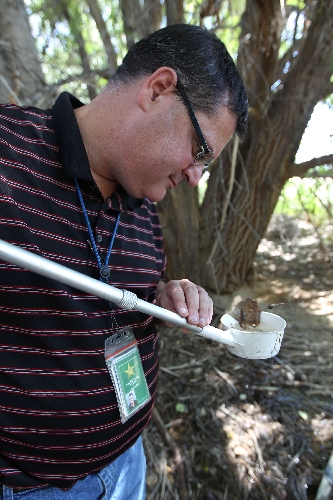West Nile virus found in valley
West Nile virus-infected mosquitoes, responsible for more than 40 human deaths in the United States this year, are now circulating in the Las Vegas Valley.
That notification, made Tuesday by the Southern Nevada Health District, comes as officials with the federal Centers for Disease Control and Prevention call the current West Nile outbreak one of the largest in U.S. history, with four times the usual number of cases. More than 1,200 illnesses have been reported, about half of them in Texas, which has resorted to aerial spraying to beat back what researchers there call an epidemic.
Normally, fewer than 300 cases are reported nationwide by mid-August.
News that the virus has been found among mosquitoes in Nevada should be a warning signal to residents but not a cause for great alarm, said Larry Rogers, a senior environmental specialist with the health district.
"We have trapped them in the 89107 area code in central Las Vegas, and we believe they are now throughout the area, but there is no reason to panic," he said before heading out to Floyd Lamb Park at Tule Springs in northwest Las Vegas to set more traps.
People can jog and walk and play in parks and other areas of the valley, he said, but "it would be best if they move their activities to times other than dusk and dawn."
Mindful of what has happened in Texas, Rogers said 100 traps for mosquitoes have been placed throughout the valley.
Severe cases of West Nile virus affect nervous systems and cause encephalitis, an inflammation of the brain, and meningitis, which causes inflammation to the membrane around the brain and spinal cord.
Those most at risk are the very young and the very old who have underlying health issues.
"The mosquitoes we're talking about don't really get up and around in the daytime," Rogers said, adding that people who choose to exercise and participate in outdoor activities in the darkness or near darkness should wear long-sleeve shirts and pants.
Those people also should apply an insect repellent containing N,N-Diethyl-meta-toluamide, also known as DEET.
At this time, there have been no human cases of West Nile in Nevada, but a horse with the disease "had to be put down" in Northern Nevada, Rogers noted.
Rogers stressed that people should get rid of mosquito-breeding sites by emptying standing water from flower pots, buckets and barrels. Water in pet dishes and birdbaths should be replaced weekly.
When they're not being used, children's wading pools should be kept empty and on their sides. Swimming pools should be regularly cleaned.
West Nile virus first appeared in the United States in New York in 1999. Mosquitoes pick up the virus from infected birds and transmit it to humans, birds and other animals they bite.
In rare cases, the disease has been spread among humans through breastfeeding, organ transplants and blood transfusions. It is not spread through casual contact such as kissing or touching a person with the virus.
Last year, Nevada reported 16 cases of West Nile, 11 of them in Clark County. One person died from the disease.
The worst year of the virus in Clark County remains the first, 2004, which had 23 cases. Since 2004, there have been five deaths statewide from the disease, according to the Nevada State Department of Health.
Earlier this summer, a blood donation tested in Las Vegas was found to have traces of the virus, Rogers said. The donor had no visible symptoms.
"You have to remember that 80 percent of the people who contract the virus never even have symptoms," he said.
According to the CDC, those suffering from the severe form of the virus, about one in 150 cases, often experience high fever, headache, neck stiffness, stupor, disorientation, coma, tremors, convulsions, muscle weakness, vision loss, numbness and paralysis.
The symptoms may last several weeks, and neurological effects may be permanent.
More than 30,000 people in the United States have been reported with West Nile virus disease since 1999. Of those, almost 13,000 have been seriously ill, and more than 1,200 have died.
There is no specific treatment for the virus. Victims are hospitalized and receive supportive treatment, including intravenous fluids, help with breathing and nursing care.
The less dangerous, or non-neuroinvasive, form of the disease usually produces symptoms similar to those of the common cold: fever, headache, nausea, diarrhea, loss of appetite and backache.
"Unfortunately," Rogers said, "the small mosquito is a very effective carrier of disease. It has been the scourge of humanity, and we have to keep the upper hand."
Contact reporter Paul Harasim at pharasim@review
journal.com or 702-387-2908.


















